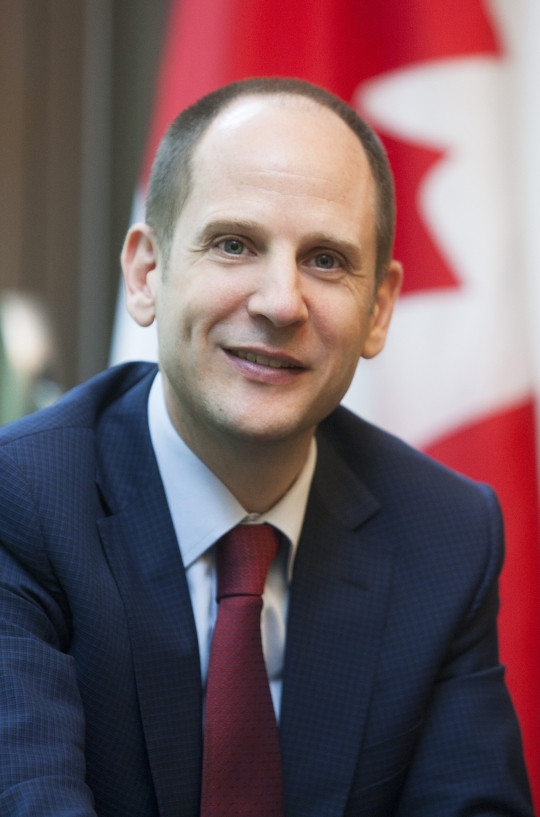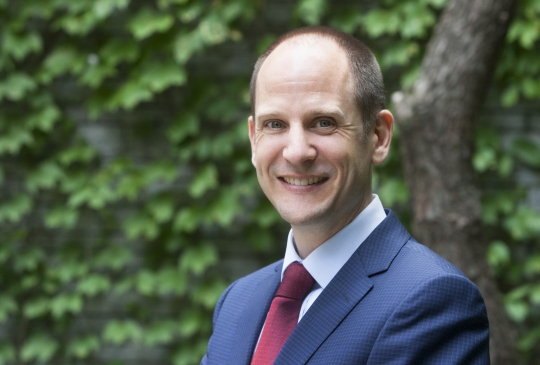"Diversity is Equal to Diverse Talents."
Canada, a country of gender equality and respect for diversity
Work-family balance to be facilitated by role models
Media to work as an engine for change
The young Prime Minister of Canada, Justin Trudeau constituted the gender-equal cabinet after his inauguration on November last year. He created a sensation, having mentioned the reason for the half of the members of the cabinet being female that it was just 2015 now.

The Women’s News recently met with H.E. Ambassador Eric Walsh of Canada to Korea (Photo) to learn the situation of work-family balance and diversity in Canada where the gender-equal cabinet is naturally accepted by the public. Ambassador Walsh started for his post in Korea in the beginning of February last year. He said he had been impressed by Korean women in high ranking positions and various fields, adding that he confirmed that a lot of women in Korea strive for advancing into high positions even in the economic field at the breakfast meeting organized for female CEOs in Korea when Minister of International Trade of Canada, Ms. Chrystia Freeland visited Korea last May.
-How are the lives of working families in Canada?
“ ‘Work-family balance’ is also a challenge for Canada. Canada makes efforts for women to continue their career even after childbirth. To do so, certain legal measures are in place for parental leave and returning to work after parental leave. Returning to the original position after parental leave finally ends up with corporate benefits. If the very human resources leave the company forever, that is such huge loss for the company.
There are also certain legal means to prevent not only sexual discrimination but also all kinds of discrimination based on race, religion and so forth, at workplaces. A company is legally prohibited from asking interviewees about their family plans.
There are also a lot of signals of cultural changes as well as political ones. The Foreign Ministry of Canada once had a regulation to prohibit a married woman from being a diplomat even after the World War II. But, after a long period of time of over 60 years, Canada has the gender-equal cabinet and more female ambassadors than any other countries. Given these cultural changes occur very gradually, important factors in that change I want to point out are role models and the role of media.
Canada went through a process of sharing experiences of mothers in the society and finally realized that mothers have positive roles in social and economic activities and provide new perspectives to the labor market. If good cases of working mothers are recognized and settled in the society, the young generation will take those as role models as their driving forces. For example, I’d like to talk about the case of Ms. Christy Clark, the Premier of British Columbia, Canada, who is the first female premier in Canada. She gave birth to a child in 2001 while she was in office as Minister and took her child to the office. This episode made her famous. Ms. Clark received an honorary doctorate at Sookmyung Women’s University last May (2016), giving her speech with this comment that women should not be afraid of making new rules when having seats at decision-making tables, which is not easy but what they have to do for those who will come after them.
Another critical driving force for change is ‘media’ in terms of providing role models for the young generation. Women characters shown in action movies and sitcoms would change people’s recognition towards women.”
-The gender-equal cabinet of Prime Minister Trudeau attracted such attention of the world.
“Yes. Prime Minister Trudeau started to recruit women candidates for the members of his future cabinet as soon as he had become the representative of the Liberal Party. Minister Freeland had been a journalist, living in New York with her family, and one day got a call from Mr. Trudeau. In this way, he continued to meet female candidates in advance to make a pool to complete the picture of his cabinet. Those candidates were already successful women and wonderful in the sense that they were trying to help other women. In Canada, it is general for women to advance into the Parliament, the Cabinet, and state governments.
In Korea, you have the female President. Girls could have a dream of becoming the president since they experience a women President.
Meanwhile, the Cabinet of Trudeau also embraced such various groups as natives, new Canadians and the like, which is the balanced reflection of the constitution of Canada’s population. It was the outcome of his careful preparation of candidates.

-Canada respects diversity.
“For Canada, a multi-cultural country, diversity is a kind of DNA. The Government considers diversity in four ways which are women, minority groups, natives and the handicapped. All the governmental agencies try to reflect the population proportions of these groups in their organizational constitution. In the case of the Canadian Embassy in Korea, women workers represent 60%.
The Parliament has also had diversity in terms of its constitution. Vancouver and Toronto are the representative cities of diversity. I went to high school in Toronto. Back then, girls and boys represented half and half of the total students. There were also Asian friends. I just naturally called their names with their first names and hung around without being conscious of their family names or their races. Even though they had different English accents, it did not become a reason of discrimination.
Having grown up in this kind of circumstances, I naturally learned diversity. The diverse constitution of the Cabinet is also one of the outcomes of this Canadian culture. Diverse backgrounds mean diverse talents. Going towards diversity is not what we might be afraid of.”
-Is diversity also reflected in education?
“Situations where diversity can be learnt exist in daily lives. Diversity is not what has to be taught but experienced. Who knows? Maybe in 20 or 30 years, talented people might be moving to a society where diversity is welcomed and respected. If you are a working woman, you would live in a society where family and work can be balanced because that means more and better opportunities.”
-Please share your story about work-family balance.
“I try not to be driven by work. Hours after work are used for personal life. Of course, it is not easy because of the time difference between Korea and Canada. When I get up in the morning, I check the job list transferred from Canada with my smart phone. I and my wife live with two dogs and two cats. I walk to work through Namdaemun Market, the Bank of Korea, and Deoksugung-gil, seeing many students and workers rushing to their destinations.”

